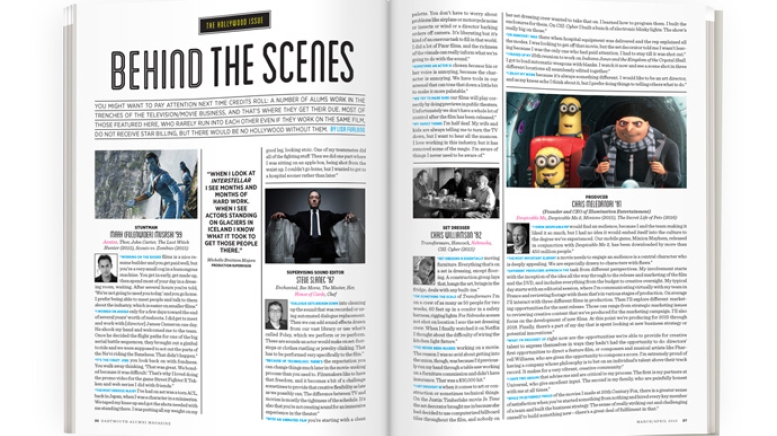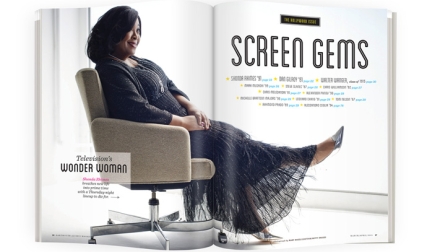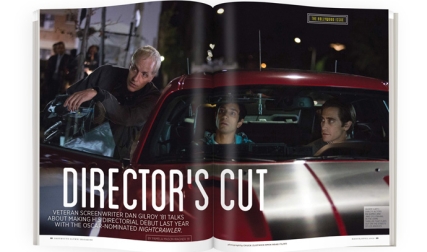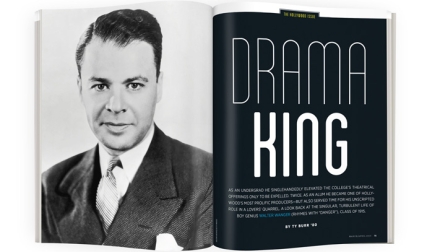Stuntman
Mark (Fulenwider) Musashi ’99
Avatar, Thor, John Carter, The Last Witch Hunter (2015), Scouts vs. Zombies (2015)
“Working on the bigger films is a nice resume builder and you get paid well, but you’re a very small cog in a humongous machine. You get in early, get made up, then spend most of your day in a dressing room, waiting. After several hours you’re told, ‘We’re not going to need you today,’ and you go home. I prefer being able to meet people and talk to them about the industry, which is easier on smaller films.”
“I worked on Avatar only for a few days toward the end of several years’ worth of reshoots. I did get to meet and work with [director] James Cameron one day. He shook my hand and welcomed me to the team. Once he decided the flight paths for one of the big aerial battle sequences, they brought out a gimbal to ride and we were supposed to act out the parts of the Na’vi riding the Banshees. That didn’t happen.”
“It’s the crazy jobs you look back on with fondness. You walk away thinking, ‘That was great. We bonded because it was difficult.’ That’s why I loved doing the promo video for the game Street Fighter X Tekken and web series I did with friends.”
“The most serious injury I’ve had on set was a torn ACL, back in Japan, when I was a character in a miniseries. We taped my knee up and got the shots needed with me standing there. I was putting all my weight on my good leg, looking stoic. One of my teammates did all of the fighting stuff. Then we did one part where I was sitting on an apple box, being shot from the waist up. I couldn’t go home, but I wanted to get to a hospital sooner rather than later.”
Supervising Sound Editor
Steve Slanec ’87
Enchanted, Bee Movie, The Master, Her, House of Cards, Chef
“Dialogue gets broken down into cleaning up the sound that was recorded or using automated dialogue replacement. Then we can add sound effects drawn from our vast library or use what’s called Foley, which we perform or re-perform. These are sounds an actor would make on set: footsteps or clothes rustling or jewelry clinking. That has to be performed very specifically to the film.”
“Because of technology, there’s the expectation you can change things much later in the movie-making process than you used to. Filmmakers like to have that freedom, and it becomes a bit of a challenge sometimes to provide that creative flexibility as late as we possibly can. The difference between TV and movies is mostly the tightness of the schedule. It’s also that you’re not creating sound for an immersive experience in the theater.”
“With an animated film you’re starting with a clean palette. You don’t have to worry about problems like airplane or motorcycle noise or insects or wind or a director barking orders off camera. It’s liberating but it’s kind of an onerous task to fill in that world. I did a lot of Pixar films, and the richness of the visuals can really inform what we’re going to do with the sound.”
“Sometimes an actor is chosen because his or her voice is annoying, because the character is annoying. We have tools in our arsenal that can tone that down a little bit to make it more palatable.”
“We try to make sure our films will play correctly by doing previews in public theaters. Unfortunately we don’t have a whole lot of control after the film has been released.”
“My family thinks I’m half deaf. My wife and kids are always telling me to turn the TV down, but I want to hear all the nuances. I love working in this industry, but it has removed some of the magic. I’m aware of things I never used to be aware of.”
Set Dresser
Chris Williamson ’82
Transformers, Hancock, Nebraska, CSI: Cyber (2015)
“Set dressing is essentially moving furniture. Everything that’s on a set is dressing, except flooring. A construction group lays that, hangs the art, brings in the fridge, deals with any built-ins.”
“On something the scale of Transformers I’m on a crew of as many as 50 people for two weeks, 60 feet up in a condor in a safety harness, rigging lights. For Nebraska scenes not shot on location I was the set dressing crew. When I finally watched it on Netflix I thought about the difficulty of wiring the kitchen light fixture.”
“I’ve never been injured working on a movie. The reason I was so avid about getting into the union, though, was because I’d previously run my hand through a table saw working on a furniture commission and didn’t have insurance. That was a $30,000 hit.”
“I get brought in when it comes to art or construction or sometimes technical things. On the Justin Timberlake movie In Time the set decorator brought me in because she had decided to use computerized billboard tiles throughout the film, and nobody on her set dressing crew wanted to take that on. I learned how to program them. I built the enclosures for them. On CSI: Cyber I built a bunch of electronic blinky lights. The show’s really big on those.”
“On Hancock I was there when hospital equipment was delivered and the rep explained all the modes. I was looking to get off that movie, but the set decorator told me I wasn’t leaving because I was the only one who had paid attention. I had to stay till it was shot out.”
“I passed up my 25th reunion to work on Indiana Jones and the Kingdom of the Crystal Skull. I got to load automatic weapons with blanks. I watch it now and see a scene shot in three different locations all seamlessly edited together.”
“I enjoy my work because it’s always something different. I would like to be an art director, and as my knees ache I think about it, but I prefer doing things to telling others what to do.”
Producer
Chris Meledandri ’81
(Founder and CEO of Illumination Entertainment)
Despicable Me, Despicable Me 2, Minions (2015), The Secret Life of Pets (2016)
“I knew Despicable Me would find an audience, because I and the team making it liked it so much, but I had no idea it would embed itself into the culture to the degree we’ve experienced. Our mobile game, Minion Mayhem, released in conjunction with Despicable Me 2, has been downloaded by more than 450 million people.”
“The most important element a movie needs to engage an audience is a central character who is deeply appealing. We are especially drawn to characters with flaws.”
“Different producers approach the task from different perspectives. My involvement starts with the inception of the idea all the way through to the release and marketing of the film and the DVD, and includes everything from the budget to creative oversight. My typical day starts with an editorial session, where I’m communicating virtually with my team in France and reviewing footage with them that’s in various stages of production. On average I’ll interact with three different films in production. Then I’ll explore different marketing opportunities for the next release. Those can range from strategic marketing issues to reviewing creative content that we’ve produced for the marketing campaign. I’ll also focus on the development of new films. At this point we’re producing for 2015 through 2018. Finally, there’s a part of my day that is spent looking at new business strategy or potential innovations.”
“What I’m proudest of right now are the opportunities we’re able to provide for creative talent to express themselves in ways they hadn’t had the opportunity to do: directors’ first opportunities to direct a feature film, or composers and musical artists like Pharrell Williams, who are given the opportunity to compose a score. I’m extremely proud of having a company whose philosophy is to bet on an individual’s talent above their track record. It makes for a very vibrant, creative community.”
“I have two groups that advise me and are critical to my process. The first is my partners at Universal, who give excellent input. The second is my family, who are painfully honest with me at all times.”
“While I’m extremely proud of the movies I made at 20th Century Fox, there is a greater sense of satisfaction when you’ve started something from nothing and hired every key member of a team and built the business strategy. The sense of really striking out and challenging oneself to build something new—there’s a great deal of fulfilment in that.”
Art Director/Production Artist
Alexander Panov ’96
Spider-Man 3, Angels & Demons, The Social Network, The Girl with the Dragon Tattoo
“First I need to understand when the story takes place. I look at the references of architecture and have creative discussions with the director and production designer, who may have specific requirements for a set. Occasionally we have to create or depart from accepted standards in construction, make forced perspectives in order for objects to appear farther away. Routinely we make walls of movie sets removable or movable in order for the camera to see from different angles. If we build them, ceilings are removable.”
“I’m in charge of all set surfaces: finding the right wallpaper or the right kind of furniture for a period piece, the right paint—anything that shows up on the screen, anything an actor touches. Early on, I especially enjoyed the interaction of materials and techniques used to make things look old.”
“In The Girl With the Dragon Tattoo I designed the handwriting style of Daniel Craig’s character and treated the paperwork used in his archival research. I created the diagrams. I was in charge of creating a look that would match the locations in Sweden.”
“For Angels & Demons we had to create St. Peter’s Square in a parking lot in Inglewood, California, which isn’t a very nice area. The filmmakers had to stop shooting at the Vatican when they wanted to blow things up. They were going to do more there but had to settle for façades.”
“Every director is different. Ron Howard is very collaborative, just a sweet person. David Fincher is a dictator but very knowledgeable. My primary source of information, though, is the production designer.”
“Work in Hollywood is about being in the field and meeting people and learning on the job—apprenticeship and mentorship situations. Because it’s unionized this is hard to do.”
Production Supervisor
Michelle Brattson Majors ’96
Charlie Wilson’s War, Frost/Nixon, Star Trek Into Darkness, Neighbors, Interstellar
“I love being involved in something that’s happening rather than sitting at a desk and reading scripts. The most interesting thing about my job is the hundreds of different types of craftspeople and artists and administrators and accountants—all the people who come together to work on one movie. My role is to manage and help facilitate what the director wants to do creatively. All these elements have to combine at the right time, in the right place for the right amount of money. There’s a lot of juggling and a lot of adapting. There’s a lot of stress and a lot of competing personalities, but people want to shine most of the time.”
“When there are scenes being shot, there are very few people who are critically involved. There were many, many people who brought elements to the table that are happening at that moment. I’m called on set because there’s some kind of issue that needs to be resolved or some diplomacy that needs to happen. If I’ve done my job well and the people who work with me have done their jobs well, we’re thinking about next week and next month.”
“When I look at Interstellar I see months and months of hard work. We were under an immense time-schedule pressure when it came to building the interiors of the spaceships. What’s amazing is that these were real working sets that were created in lieu of shortcuts that can be taken. When I see actors standing on glaciers in Iceland in the film, I know what it took to get all those people there, to get all that equipment there. I know what it meant for filmmakers to have actors working there instead of putting them on a stage in front of a green screen, and that is very meaningful to me.”
“There is a lot of hard work and sometimes it feels impossible, but at the end of the day you’re standing there on set, people are working and shooting and making their movie, and you’re relieved. It’s a weird experience. It’s a circus environment, probably like any artistic endeavor, like a Broadway show.”
Writer
Leonard Chang ’91
Justified
“When I got to L.A. about six years ago I began writing TV pilots trying to create my own show. I soon realized I needed to better understand the business, so I started staffing on other shows.”
“By the time I got to work on Justified I was intimately acquainted with all the characters. I’d been an admirer of [creator] Graham Yost from watching Boomtown, and when I heard he was adapting Elmore Leonard I knew it would be the kind of show I would love. Now, with the final season, there’s a sense of impending loss that’s permeating everything, but everyone on the show understands this is the perfect time to end. We want to go out on top.”
“Writing for television is very collaborative. It’s also an arduous, complicated process. For season six of Justified we got together in July and didn’t start shooting until late September. There are 10 of us who sit in a room from about 10 in the morning till 6 at night and talk about the stories we want to tell. We go individually by character. It’s a negotiation and Graham is guiding us. Then people add their own ideas and research. We begin with episode one and list our story points on whiteboards. Once we have that, a couple of writers go off and write an outline, often coming back with questions we discuss as a group. Then they go off to script. We all have favorites, but every writer has to be able to write for every character. The actors are part of the discussion.”
“It’s really important for us to do right by the people of Harlan, Kentucky, because it’s a Harlan-centric show. We make yearly research trips to keep our sensibilities in check.”
“We don’t get a whole lot of notes from the studio network in terms of things we can’t do. It’s very open. I think everyone feels they’re in this golden age of TV, so they want to encourage as much creativity as possible. We are really lucky to be in this time, so my peers and I are just taking advantage of this as much as we can.”
“A lot of us from Justified will be working together again. I’m actively trying to adapt my Allen Choice novels for the screen.”
Storyboard Artist
Raymond Prado ’89
Sommersby, X-Men, Two Weeks Notice, Night at the Museum: Secret of the Tomb, The Hunger Games: Mockingjay (1 and 2)
“When I was at a football team training camp, I used the coaches’ whiteboards after workouts to draw caricatures and other members of the team would have to guess who it was.”
“I got my first storyboard job because I was young and understood hip-hop culture. The old-timers who were around didn’t get hip-hop but they taught me. When kids ask me how to get work I tell them, ‘You have to be there.’ ”
“Sometimes with live-action movies you’re starting to work without a script, to make boards that can help sell a film to producers. Hunger Games, of course, had everything together. Working on a sequel is great because all we want is a little direction. The choices you could otherwise make seem infinite.”
“When I moved from L.A. back to Vermont I thought about giving up movie work, but I could never say no to Taylor Hackford. I had a very special experience working with him as a second unit director on Ray. I took Jamie Foxx around to create a montage of Ray meeting women by touching their hands. And I was there when Jamie met the real Ray Charles.”
“When I started working on X-Men in Canada, there was kind of a script but no one knew what the movie was going to be. The director had ideas, producers had ideas and creative people like me had ideas. The movie hadn’t been green lit and there was concern about costs. They were telling us a fight scene had to be shot inside the Statue of Liberty. I did a charcoal drawing of one of the characters getting blasted out the statue’s head to show why we needed to shoot outside.”
“It’s a very intensive, creative process and it depends on the director you have. Some are very visual. Some say, ‘See what you can come up with.’ What I love most about what I do is being there at the beginning with an idea. It’s a weird job for sure.”
Animation Rough Layout Artist
Alessandro Ceglia ’94
Madagascar 3, Kung Fu Panda 3 (2016), How to Train Your Dragon 2
“The rough layout department is usually on a movie for about a year and a half, but you don’t always get to complete a film. I rolled off How to Train Your Dragon 2 a few months early so I could help out on Kung Fu Panda 3 from the beginning.”
“Generally we start with a story reel that we get from the story and editorial departments: static storyboards cut together with an audio track. We’re the first department that works in 3-D. We create rough blueprints for movies, working with the editorial department and the director. You work sequence by sequence and present periodically as it’s in progress. You get lots of notes in the back and forth. Eventually you reach an approved sequence with a rough representation of the lighting, the effects work, the animation and the camera work. Also, shot lengths will be determined. Once anything gets approved in our department it progresses downstream to departments like character animation and effects. Unless there is radical re-engineering of a sequence, which does happen, the final layout department will make any adjustments.”
“Rough layout is essentially a legacy term from the old 2-D animation days. In today’s CG 3-D animation world the term varies from studio to studio. The modern term is ‘previsualization’ or ‘previs,’ but at Dreamworks we’re still called ‘rough layout artists.’ ”
“The main reason I left a corporate job was to pursue a creative career. I thought if I could be successful at something I didn't love I could be even more successful doing something I love. To this day, the thing that brings me the most satisfaction is having something concrete you made, to look at and be proud of. On a Friday I cannot leave and enjoy my weekend unless I’ve finished whatever I’m working on and I’m happy with it.”




